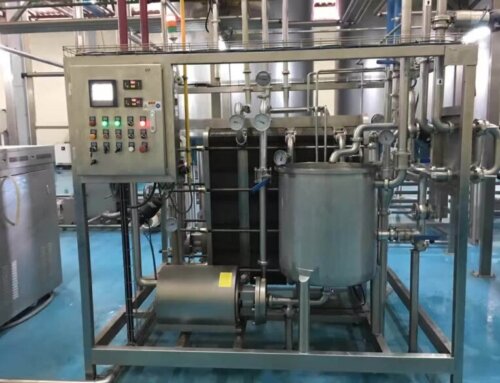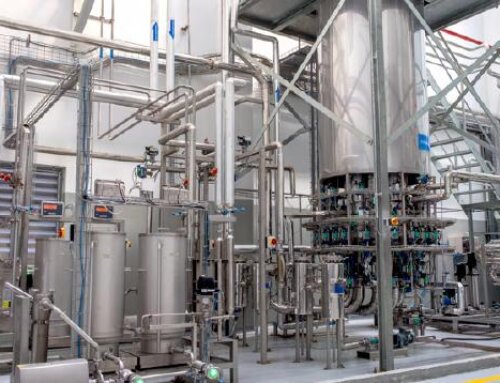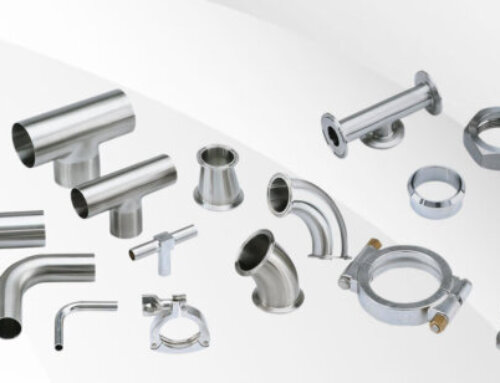Reconstituted Milk Processing Description
- Reconstituted milk, also known as “recombined milk”, refers to concentrating and drying fresh milk into milk powder, and then using the milk powder as raw material, and adding an appropriate amount of water and other ingredients to make it into liquid milk with the same ratio of water and solids as in raw milk. Since reconstituted milk is produced with milk powder as raw material, compared with raw milk, the storage, transportation and shelf life of milk powder has a bigger advantage than fresh milk due to water being removed in milk powder.
- The manufacturers are suitable for starting the reconstituted milk processing in their area in the following three situations: Some countries do not have enough fresh raw milk; In some areas, the fresh raw milk supply is not stable and regular; The raw milk transportation is in long distance and lack of the chilled conditions to store the fresh milk.
- Although the reconstituted milk raw materials are in heat treatment through concentrating and spray drying processes, most of the nutrients are retained, especially the high-quality protein and calcium we want to obtain from milk. Heating these two components is almost not affected by high temperatures. Protein is mainly to provide amino acids to the human body, heat denaturation will not cause it to lose nutrients, but it will also help digestion and absorption. Calcium itself is an inorganic salt and will not change its structure when heated. At present, most reconstituted milk use UHT sterilization technology, which can kill harmful bacteria while retaining a large number of nutrients, and the safety of milk is effectively guaranteed.
- The process for reconstituted milk includes milk powder dissolving, fats and flavors dissolving, liquid milk blending and formulation, milk homogenizing, degassing and UHT sterilizing, filling and packing into the containers. The whole production line involves a milk powder mixer, a high shear dissolving tank, blending tanks, UHT sterilizing system, a bottle/carton filling system, a packing system, RO pure water generating system, hot water generating system, a CIP system, pipelines, valves, and pumps. All the machines are made of SUS304/316L food-grade material.
- The raw materials and ingredients for recombined milk production are skim milk powder or whole milk powder, pure water, stabilizers, emulsifiers, milk fat, flavors, etc.
- The capacity of the reconstituted milk processing plant is from 500L/H to 10000L/H, and the end products can be filled into aseptic cartons, bottles or pouches, and the shelf life of the products can reach 6-12months.
- The reconstituted milk processing line can be also used for producing recombined juice, yogurt and other recombined products.

Reconstituted Milk Ingredients Introduction
Milk powder
The quality of the milk power is very important for the final products. The particle size of the milk powder has a great relationship with the reconstitution, recovery and dispersion of the milk powder. When the particle size of the milk powder is 150μm, the reconstitution performance is the best, which can reach 99%. The milk powder used as reconstituted milk is preferably produced by centrifugal spray drying or pressure spray drying, and its particle size is between 30-200 μm. The whole milk powder or skim milk powder should be pale yellow. Not only the particle size and color of the milk powder, the water content(3%-5%), microorganism, fat globule (1-3μm) and protein should also be considered when choosing the raw materials.
RO pure water
Purified water is an indispensable and important raw material for the production of reconstituted milk. The water need to be pure drinking water, free from harmful microorganism and low hardness. The recommend pure water pH is 7-8, total solids less than 500mg/L, total hardness 5.5DH.
Milk fat
Anhydrous milk fat is used for producing the recombined milk. The fat content is ≥99.8, and the water content is ≤0.1%, it should be packed in oxygen-free containers.
Stabilizer and emulsifiers
Gelatin, Phosphates, Carrageenan, and Xanthan Gum can be added to the milk to stabilize the fats in milk and prevent sedimentation during storage. 0.2%-0.3% dosage can be added into the milk.
Here attached the reconstituted milk recipe for reference:
| Ingredients | Percentage |
|---|---|
| Skim Milk Powder | 8%-9% |
| Fat | 3%-4% |
| Stabilizer | 0.25%-0.6% |
| Flavor | 0.1% |
| Water | 85%-87% |
Reconstituted Milk Process Flowchart
Reconstituted milk is produced by dissolving milk powder in RO hot water with continuous stirring to ensure complete hydration, then blended with other ingredients like vitamins, minerals, fats with liquid milk in blending tanks, followed by homogenization and degassing to achieve uniform fat distribution and air elimination. The mixture is then subjected to pasteurization (72-75°C for 15-20 seconds) or ultra-high temperature (UHT) sterilization (135-150°C for 2-4 seconds) to eliminate harmful microorganisms. After heat treatment, the reconstituted milk will be filled into containers such as Tetra Pak cartons, PET bottles, or glass bottles according to customers’ requirements and different process flowcharts for safe distribution and consumption.

Reconstituted Milk Process And Machine Introduction
Milk powder and fats dissolving system
The milk powder and fat solids can be dissolved in a water powder mixer and high-shear mixer machine according to the dissolving capacity. The best dissolving temperature will be 55℃-60℃, with this temperature, the milk powder can be dissolved into a liquid state in half hour and the fats will be emulsified. Milk powder can be manually fed into the water powder mixer or fed into the high-shear mixer by the screw elevator.

Reconstituted milk blending system
After the milk powder and fats dissolve into the emulsion, then pumping into the blending tanks, and at the same time dosing the remaining pure water into the mixing tank according to the recipe. To prevent air incorporation during mixing, vacuum mixing can be used in blending tanks. Usually, two or three blending tanks are equipped with a blending system to ensure the continuity of production.

UHT treatment system of reconstituted milk
When the reconstituted milk is filled into the Tetra Pak package, before milk UHT treatment, it needs to be preheated to 60-70℃ for degassing and homogenization. After that, the milk will be heated to 137℃ and held for 3-5S for sterilizing by hot water indirect heating. and then the reconstituted milk will be cooled to 30℃ for aseptic filling.
When the milk is filled into the bottles, it will be heated to 60-70℃ for homogenizing and degassing, then the milk will be filled into the bottles directly, no need sterilization before filling, after filling into the containers, the reconstituted milk will be fed into the retort sterilizer for sterilization with 121℃ with 15-20minutes.
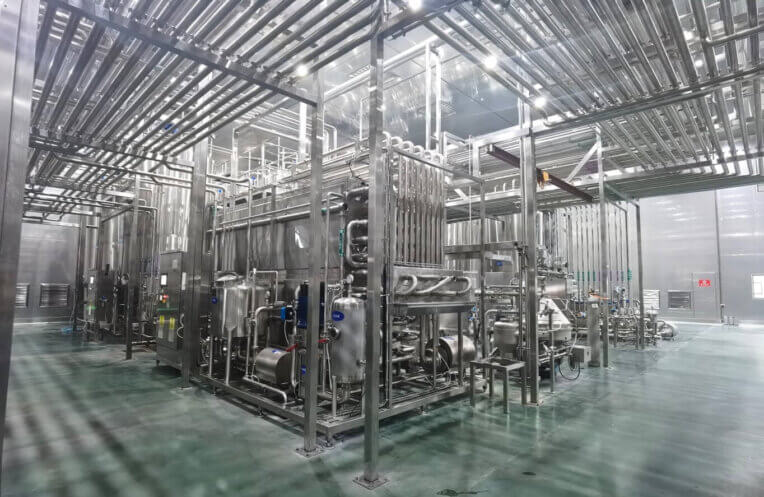
Reconstituted milk filling and packing system
The reconstituted milk can be aseptically filled into Tetra Pak cartons, after filling, there is no need for secondary sterilizing.
The reconstituted milk can also be hot-filled or aseptically filled into the bottles. When hot filling, the milk in bottles will be sterilized again by the retort sterilizer, and then cooled to room temperature after labeling, date coding, and packing into the cartons or shrink packages.

RO water treatment system for reconstituted milk plant
A Reverse Osmosis (RO) water treatment system is essential for a reconstituted milk plant to ensure high-quality water free from impurities, bacteria, and dissolved solids, which is crucial for consistent milk reconstitution. The RO water treatment system includes the water storage tanks, pre-filtration system(sand filter, carbon filter, and ion exchanger), RO equipment, and Ozone/UV water sterilizer. The tap water or ground water after RO treatment can be used for process water in reconstituted milk plant for milk powder dissolving and final milk volume fixing.
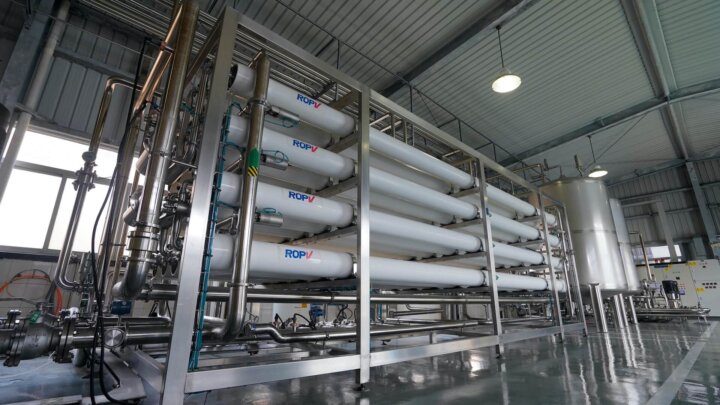
CIP cleaning station for reconstituted milk plant
A Cleaning-in-Place (CIP) system is essential for maintaining hygiene and ensuring product quality in a reconstituted milk plant. It allows the automatic cleaning and sanitization of tanks, pipelines, pasteurizers, UHT systems, and filling machines without dismantling the equipment. The main function of CIP system in reconstituted milk processing plants is as follows:
- Removes milk residues, fats, proteins, and microbial contaminants
- Prevents bacterial growth and cross-contamination
- Ensures compliance with food safety standards (e.g., HACCP, FDA, EU regulations)
- Reduces downtime and labor costs compared to manual cleaning

